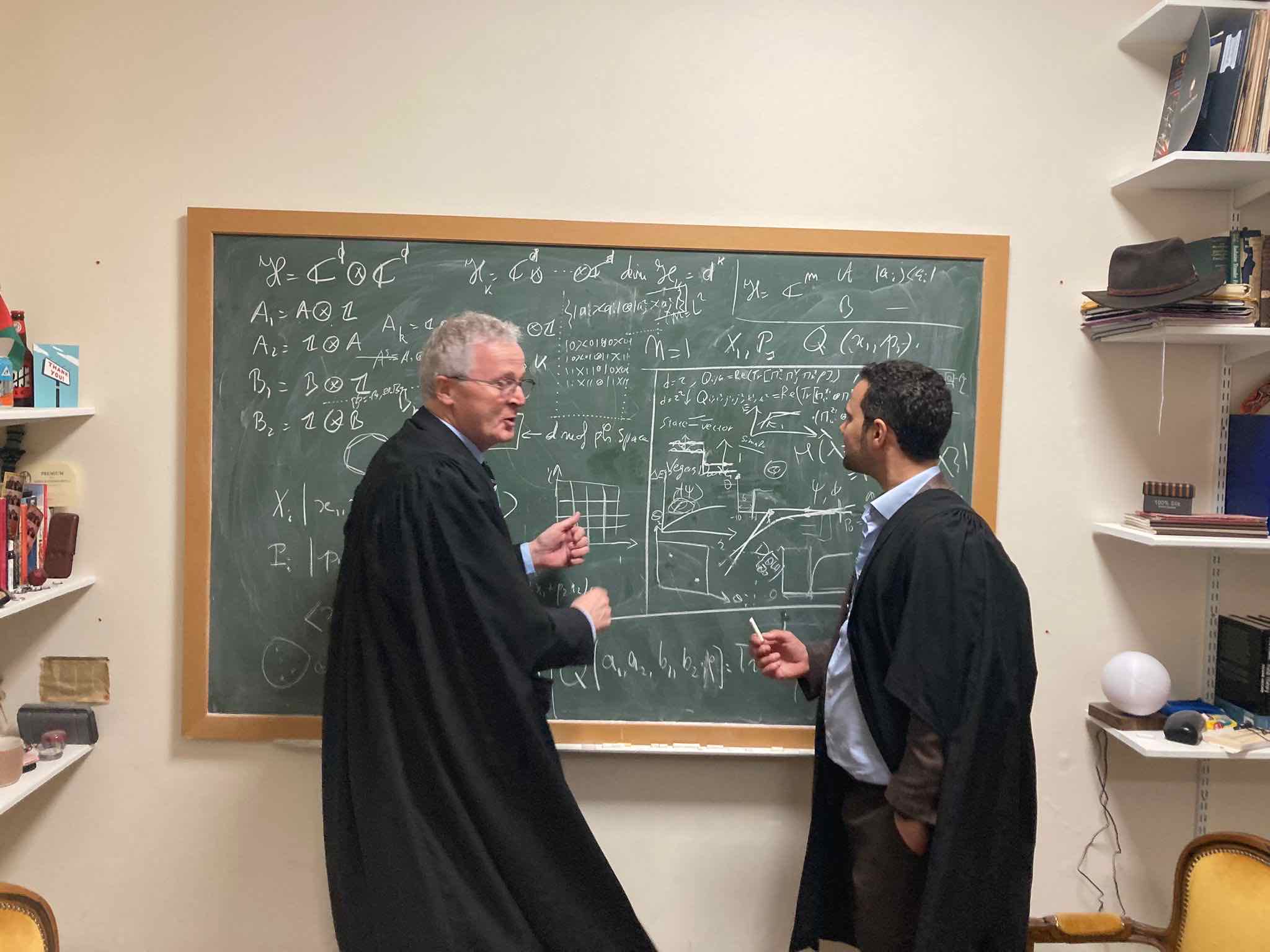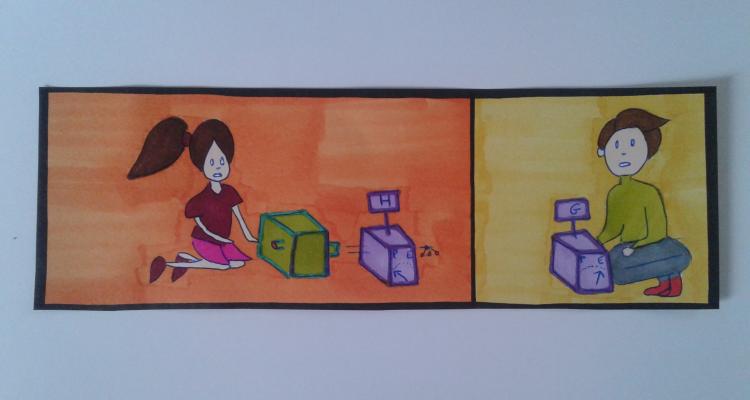I do not say science is useful because it helps us build machines.
I say machines are useful because by working for us
they will allow us one day to do more science.
- Henri Poincaré, La valeur de la science, 1905.
The Many Marvels of Quantum Mechanics
by Stephan De Bièvre (*)
Participating in Cambridge college life as the Brenda Ryman Visiting Fellow at Girton College during the Easter Term 2024 has been a true privilege and an exceptionally enriching experience.
The impressive Victorian college building with its fine art and furniture collections, exquisite gardens and extensive grounds creates the perfect conditions for unfettered scientific work. The warm welcome of the fellows and staff further contributed to make me feel very much part of the college community and set the stage for a fruitful collaboration with Girton Fellow Dr. David Arvidsson Shukur, and with our post-graduate students – the main purpose of my visit.
Towards the end of my stay, I had both the honour and the pleasure to give a Fellows Evening Research Talk. For this, I provided the rather ambitious title “The Many Marvels of Quantum Mechanics – All you ever wanted to know and never dared to ask.” However, I decided, before embarking on this subject, to first lift the veil on the mystery of what it is – precisely – that mathematicians and theoretical physicists do all day. Indeed, discussions at High Table (and on many other occasions in the past) have always left me with the impression that this question is a source of considerable  puzzlement. Although the blunt question “If these people do no lab experiments, no field trips, no data collecting, no data analysis, no computer simulations, nor spend long hours in the library, what then do they do?” is never explicitly put forward, it seems to me it is on many minds. The tong-in-cheek answer is that they dress up like wizards and stand in front of blackboards covered with cabalistic symbols, in the hope of piercing the secrets of the universe.
puzzlement. Although the blunt question “If these people do no lab experiments, no field trips, no data collecting, no data analysis, no computer simulations, nor spend long hours in the library, what then do they do?” is never explicitly put forward, it seems to me it is on many minds. The tong-in-cheek answer is that they dress up like wizards and stand in front of blackboards covered with cabalistic symbols, in the hope of piercing the secrets of the universe.
More seriously, theoretical physicists set out to design mathematical models of parts of the material world that surrounds us with the aim of describing, predicting and controlling their future behaviour. These mathematical models are abstractions that retain from the complex physical reality only those essential features necessary to answer the question at hand. As an example, whether it is the pendulum-swaying motion of the chandelier in the Cathedral of Pisa that fascinated Galileo, or the movement of a child’s swing as it is being pushed to and fro, or the vibrations of a guitar string, the essential characteristics of these various motions are all revealed in this manner to have the same basic features. This enables us to analyse the motion and provides us with the means to control it.
But, you may ask, what about quantum mechanics? Mechanics, quite generally, is the science of motion. Classical mechanics concerns itself with the motion of macroscopic systems such as planets, satellites, soccer balls, bicycles, swings, rotor blades, propellers, rods, wheels, fluids and gases. The field is 400 years old, is well understood, but is nevertheless still actively developed and researched. Quantum mechanics, on the other hand, studies the motion of microscopic systems: molecules, atoms, nuclei, electrons and beyond. Quantum mechanics is only 100 years old, it is less well understood, and it is still very actively developed and researched. Feynman has famously asserted that ‘’it is fair to say nobody understands quantum mechanics.” It turns out quantum mechanics is full of surprises because the behaviour of the microscopic world is counter-intuitive for the simple reason that it is different from the macroscopic one and hence unfamiliar. One may read here and there about the ``weirdness’’ of quantum mechanics. I don’t like that. I prefer to say that nature is beautiful and full of surprises, making its study interesting, fascinating, and fun.
The boundary between classical and quantum mechanics is neither sharp, nor easy to pin down. My research with David Arvidsson Shukur, and with our post-graduate students, concentrates on a number of aspects of this challenge.
Why is this important, or relevant, or interesting? First, this is a fundamental question in physics. It would not be intellectually satisfying to have two different theories, and not to know how they are related, nor which one applies when, and under what circumstances. This would fly in the face of the unity of physics. Furthermore, this is also a practical question, in the era of the second quantum revolution, which promises to harness the differences between quantum mechanics and classical mechanics to build faster computers, safer cryptographic systems and, more generally, the better quantum mousetrap. To do this, we need to understand fully the circumstances in which a quantum advantage can be obtained: in other words, when is it, precisely, that a physical system exhibits behaviour that can be described only by quantum mechanics, and not by classical mechanics? And we also need to know how this difference can be harnessed.
The simplest example that permits us to illustrate this quest is the so-called BB84 cryptographic protocol. This protocol proposes to use certain peculiarities of the most basic quantum systems – the so-called qubits (or quantum bits) – to provide total security for confidential communication. A layman’s presentation of the BB84 protocol can be found in Ref. 1.
I have much appreciated the presence of the genuinely interested fellows and students at the Fellows Evening Research Talk, not least because it led to a lively exchange of questions that provided valuable food for further thought.
1. S. De Bièvre, Surprenant hasard quantique, Images des Mathématiques, https://images.math.cnrs.fr/surprenant-hasard-quantique/.
(*) Vitae: Stephan De Bièvre was the Brenda Ryman Visiting Fellow at Girton College during Easter Term 2024. He is Professor of Mathematics at the Université de Lille, France. His research concerns mathematical physics, with emphasis on quantum chaos, quantum transport theory and, more recently, theoretical quantum optics and discrete-variable quantum-information theory.

